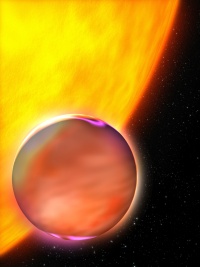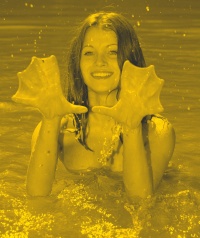Syrenian
| Syrenian žr zã̞ | |
| Spoken in: | imaginary future |
| Conworld: | the planet Syren |
| Total speakers: | ~ one million |
| Genealogical classification: | Exolang
|
| Basic word order: | SVO |
| Morphological type: | polysynthetic |
| Morphosyntactic alignment: | Unique |
| Writing system: | |
| Created by: | |
| Robert Marshall Murphy | 2013 A.D. |
The Syrenian language may be extremely difficult, but it is learnable by homo sapiens. It shares features with the Athabaskan and Inuit-Aleut languages of North America, the Semitic languages of the Middle East, and even some artificial languages created by human beings! It is remarkable different, however, owing to its unique situation. It is spoken on the planet Syren but an artificially created species of humanoids called the Syreni. They have many characteristics in common with the mermaids of Earthlore and they lead absolutely nomadic lives. In order to attempt to learn the language, it is important that you learn some things about the planet Syren, Syreni physiology, the sounds of Syrenian, the parts of each word that are conjugated, and the parts that are suffixed. Information about the planet and physiology is on this page below.
- Phonology
- "Sides"
- Prepositions
- States
- Modes
- Suffixes
- Lexicon (of roots only!)
- Texts
- The North Wind and the Sun
- The Donkey Beater Story
Syren
The planet itself is remarkably different from Earth. There are no terrestrial formations at all. That is, the entire planet is ocean, apart from the frozen, polar regions. Syren, however, does not lack “land”. Vast numbers of mobile “islands” exist - undulating platforms, ranging in size from a few square meters to dozens of square kilometers. Trees and other large flora grow there, though they are far more flexible than their Terran counterparts. A bewildering array of fauna exist too, a sizable majority of which is amphibious to sea and sky. “Dragons” or “dinosaurs” exist, though none has ever been observed larger than a Big Cat. Aquatic fauna also do not exist beyond a certain size, comparable to the killer whales of Earth. The entire planet is quite shallow, about a kilometer in average depth. No point is more than a few kilometers deep, apart from the Mithunal Trench (of which we still have not found the bottom).
A continual cloud cover envelopes the planet, at about the height of Earth’s cirrus clouds. This ubiquitous fog is the color of gold or copper. The sun, moon and stars are completely unknown to the Syreni. The planet’s weak magnetic field (and general lack of ferrous rocks) mean North and South are only distinguished by the remote presence of ice. Without sunrises and sunsets, East and West can only be referenced as “with the current” or against it (but of course, that current reverses across the equatorial line). Like the temperate regions on Earth, there are but two season, wet and dry. However, their arrival and length are quite unpredictable, leading many to speculate that Syren is in a binary star system or a moon of a gas giant in a very eccentric orbit.
The oceans of Syren have a mere fraction of the salinity Earth oceans. The planet is generally smaller to Earth in size and weaker in gravity. The sidereal day is about the same, and the atmosphere is comparable, though much more humid. The onset of night is quick and the darkness is near total. There are many forms of florescent life, but for most creatures, life shuts down at night.
The environment of Syren has had a vast impact on the Syrenian language. On Earth, a great majority of time is spent without an apparent changes taking place. On Syren, change is constant. The land “waves”, the trees bend, the wind blows and nothing is ever still. There is no sun in the sky, just an ever shifting high fog. Without careful planning, an individual would drift between islands and never retain any friends or family. The largest island observed might hold a few hundred people, but no crowd of more than 20 has ever been known to exist. There are strong ocean currents which divide the planet up into "countries", of which we think there almost 1000. The currents are very difficult to cross.
On Earth, there have been a few languages that failed to distinguished between nouns and verbs. Even these human languages are difficult to grasp for English speakers. English is a verb noun-centric language (e.g. adjectives are assumed to be substantive nouns when presented alone). In Mohawk, for example, "a deer" is "that which is deering", and so on. Everything on Syren is in process: everything is always doing something, if only undulating with the sea. There are no 'things'. Try not to ask "what" but rather "what is it doing" and you will get along a lot more quickly!
Syreni
The Syreni are very particular about the disposal of their dead, so we have has limited access to studying their physiology. They are general human in appearance, with syndactyl hands and feet, and with enormous webspace. Their feet are prehensile, with the same large membranes to facilitate swimming. The bit of DNA we have been able to sample and sequence shows striking evidence of a completely human origin that has been blatantly engineered. In short, they are animal-human chimeras. The animal aspect of their origin is either totally artificial or of non-Terrestrial origin. Our current computer modeling suggests that their frontal lobes develop as separate organs, which would explain the Syreni's typically protruding forehead.
The Syreni vocal folds are incapable of opening as wide as ours do. Hence, they cannot breathe without humming and cannot say unvoiced consonants (e.g. p, t, k, ch, s, sh, etc.). Males and females are less differentiated than human beings, especially in the voice. Generally speaking, all Syreni are tenors. Syreni incisors and canines are extremely sharp and their tongues are typically short. Presumably, this is so they don't bite their own tongues off!
The Syreni all express a sense of "calling", that is, none of them wonders why they exist or what their place is in their world. Each and every one of them knows that they exist to cultivate the world and "train" other lifeforms as much as is possible. There are several species off animal which are capable of imitating speech, and they often train them to do so. The Syreni display an innate sense of order, sometimes to the point of meeting the criteria for OCD! They nurture their young, but expect them to be self-sufficient and "on-task" by approximately seven years old. The onset of teething marks the transition away from the family. Couples mate for life but freely leave each other to finish cultivating an area, which may mean they are apart for months at a time. We are at a loss to explain how they find each other again!
| Syrenian | |||||||||||||
|---|---|---|---|---|---|---|---|---|---|---|---|---|---|
| Slot: | 1 | 2 | 3 | 4 | 5 | 6 | Root | 7 | 8 | 9 | 10 | 11 | Suffix(es) |
| Function: | Case | Deixis | Class. | Person | Prep. | State | Mode | Case | Deixis | Class. | Person | ||
| For: | "On Side" | "Off Side" | |||||||||||
| Phonology • Texts | |||||||||||||

